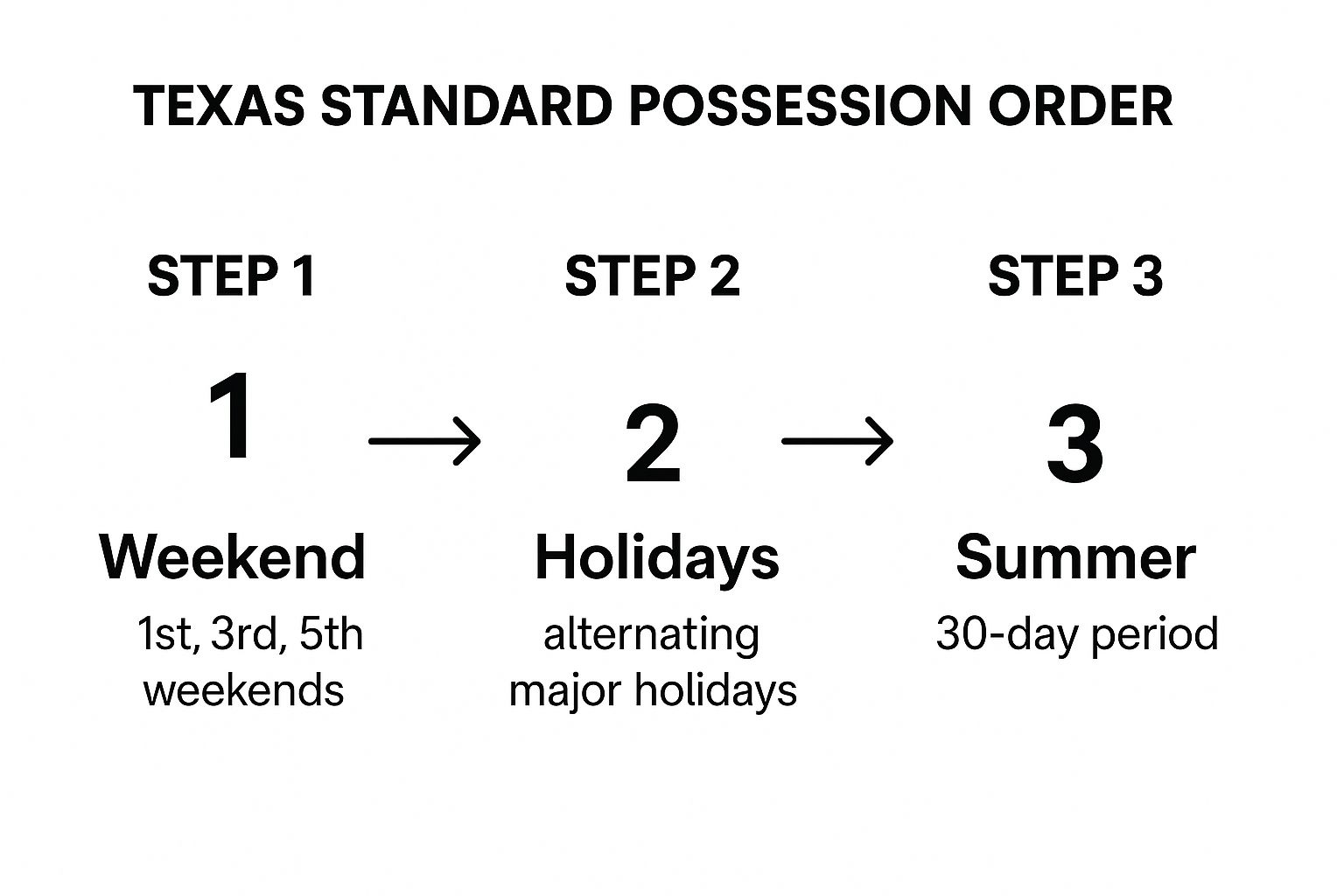When your child’s future is on the line, every single moment counts. A parenting time calculator might sound like just another online tool, but it's one of the most powerful resources you can have when navigating a Texas custody case. It takes a complex possession schedule—the weekends, holidays, and summer visits—and turns it into a clear, simple percentage.
This isn't just about keeping score. That percentage is a critical piece of the puzzle for determining child support and ensuring the final, court-ordered plan is fair for everyone involved. It equips you to advocate for a schedule that genuinely serves your child's best interests.
Why Calculating Parenting Time Is So Crucial in Texas

Navigating a child custody case can feel like you’re trying to find your way in the dark. The legal terms are unfamiliar, emotions are running high, and it's easy to feel overwhelmed. Understanding your rights and responsibilities is the first step toward regaining a sense of control. One of the most practical tools you can use is a parenting time calculator, but its importance goes way beyond just counting days on a calendar.
The Link Between Possession Time and Child Support
In Texas, the law doesn't use the term "parenting time." Instead, you'll hear the legal phrase "possession and access." This refers to the time each parent physically has the child in their care. The judge will issue a possession order that lays out the exact schedule each parent will follow.
But this schedule isn't just about logistics; it has serious financial consequences. The Texas Family Code uses a specific formula to calculate child support, and one of the most significant factors in that formula is how much time each parent has possession of the child.
Accurately calculating your parenting time percentage helps you:
- Anticipate Child Support Obligations: You'll see how a proposed schedule could directly impact how much child support you pay or receive.
- Negotiate More Effectively: In mediation, you can bring hard numbers to the table. It allows you to show how different schedules affect each parent's time and financial responsibility, moving the conversation from purely emotional to practical and fair.
- Ensure Fairness: It helps you double-check that the final court order accurately reflects the time and resources you’re dedicating to your child.
Advocating for Your Child's Best Interests
Beyond the financial aspect, a clear calculation helps you make a stronger case for a stable and predictable routine for your child. Texas courts operate under one guiding principle: the "best interest of the child." This legal standard means a judge’s top priority is always the child’s physical and emotional well-being.
When you can walk into court and present a well-thought-out possession schedule, complete with a precise parenting time calculation, you’re showing the judge that you’re focused on providing a consistent, loving environment.
It proves you’ve thought through the details and are committed to your child's stability. This strengthens your position, whether you’re creating your very first custody order or asking for a modification down the road. It turns a heated, emotional disagreement into a concrete, actionable plan—and that's how you build a powerful case for the schedule you know is right for your family.
Decoding the Texas Standard Possession Order
When parents can't agree on a schedule, a Texas judge will almost always start with a plan called the Standard Possession Order (SPO). Think of it as the default framework for most custody cases. Before you touch a parenting time calculator, you need to understand this schedule, because it’s the legal foundation that defines your rights and responsibilities.
The SPO lays out the specific times each parent will have the children. It also assigns roles in what is typically a joint managing conservatorship, where both parents share rights and duties. One parent is named the primary managing conservator—they have the exclusive right to decide where the child lives (usually within a certain geographic area). The other parent is the non-primary managing conservator, and they're the one who typically has possession of the child according to the SPO schedule.
What the Standard Schedule Looks Like
For parents living less than 100 miles apart, the SPO sets up a consistent routine. It’s designed to keep both parents deeply involved in their child's life and is legally presumed to be in the child's best interest.
So, what does that look like in practice? The non-primary parent generally gets possession of the child on:
- The first, third, and fifth weekends of any given month.
- Alternating major holidays, like Thanksgiving and Christmas.
- A significant portion of the summer, usually 30 days.
This infographic gives you a quick visual breakdown of how the Standard Possession Order typically flows.

As you can see, the SPO creates a predictable rhythm of weekends, holidays, and summer visits. This ensures the non-primary parent maintains regular and meaningful contact with their child.
To make it even clearer, here’s a simple table that breaks down the schedule.
Texas Standard Possession Order At a Glance (Parents Under 100 Miles Apart)
| Possession Period | Typical Schedule Details |
|---|---|
| Weekends | The 1st, 3rd, and 5th full weekends of a month. |
| Thanksgiving | Alternates each year. The non-primary parent gets possession in even-numbered years. |
| Christmas/Winter Break | Split into two parts, alternating each year. One parent gets the first half, the other gets the second. |
| Spring Break | Alternates each year. The non-primary parent gets possession in odd-numbered years. |
| Summer | 30 continuous days, which can be exercised in one block or sometimes split into two. Must give notice by April 1st. |
| Father's/Mother's Day | Each parent always has possession of the child on their respective holiday, regardless of the regular schedule. |
This is the baseline that judges and lawyers work from, making it a critical piece of the puzzle for any parent in a Texas custody case.
How Distance Changes the Schedule
Texas law is practical—it recognizes that a long drive makes a big difference. When parents live over 100 miles apart, the standard schedule gets a makeover to make travel more manageable and the time together more meaningful.
Instead of getting the kids every first, third, and fifth weekend, the non-primary parent might get to choose just one weekend per month. To make up for the less frequent visits during the school year, summer possession often gets a boost to 42 days.
For a much deeper dive into the nitty-gritty of these schedules, you can explore our detailed guide on understanding child visitation and standard possession orders in Texas.
This kind of precision is exactly why parenting time calculators are so useful in modern family law. Getting the numbers right is critical because it directly impacts everything from custody negotiations to child support calculations.
Knowing the baseline of the SPO empowers you. It gives you a clear picture of what a court is likely to order, providing a realistic foundation for negotiations and helping you calculate your potential time with accuracy.
Once you understand these default rules, you can use a parenting time calculator much more effectively. You’ll be able to see how your proposed schedule stacks up against the standard, which is exactly the kind of preparation you need for mediation or court.
How to Use a Parenting Time Calculator

Now that you have a handle on the Texas Standard Possession Order, it’s time to get practical. The idea of calculating your parenting time percentage might feel intimidating, but it’s more straightforward than you think. You can absolutely do this yourself with just a calendar and a pen.
The key metric that matters most is overnights. Texas courts use the number of nights a child sleeps at each parent's house over a full 365-day year to determine possession percentages. This number is what drives child support calculations and other major decisions in your case.
The Manual Calendar Method
Let's walk through this with a real-world scenario. Say you’re the non-primary parent, and your order gives you the 1st, 3rd, and 5th weekends of every month.
First, grab a calendar for the upcoming year. You're going to go through it, month by month, and physically mark every single overnight you'll have with your child.
- Weekends: A standard weekend usually means picking up after school on Friday and dropping off Sunday evening. That counts as two overnights—Friday and Saturday night.
- Holidays: Don't forget to factor in your holidays. If it’s an even-numbered year, you might have Thanksgiving; if it’s odd, you get Christmas. Mark them down according to your specific order.
- Summer: This is a big one. Block off your full 30-day summer possession. This chunk of time will make a huge difference in your final count.
Once your calendar is marked up, simply count every overnight you highlighted. Take that total, divide it by 365, and then multiply by 100. That’s your parenting time percentage. Doing this by hand can feel empowering; it gives you a tangible sense of your time. Our Standard Possession Order Calendar is a great visual tool to help you map everything out.
Using an Online Parenting Time Calculator
While the manual method works, it’s also easy to make a mistake. That’s where an online parenting time calculator can be a lifesaver. These tools are built to do the math for you, giving you an accurate number in minutes.
To get started, you'll need to plug in the specific details from your possession schedule. Be ready to enter information like:
- The school district calendar for the year.
- Your exact holiday schedule (e.g., "I have Thanksgiving in even-numbered years").
- The start and end dates for your summer possession period.
- Any other unique rules or customizations in your court order.
The calculator crunches all that information and spits out your total overnights and your possession percentage. It takes out the guesswork and gives you a solid, defensible number to use in court or during negotiations. For a deeper look into the different ways to figure out your schedule, you can read more about how to calculate parenting time.
The goal isn’t just to get a number, but to understand what that number represents—your direct, hands-on time raising your child. It’s a tangible measure of your involvement and responsibility.
This is more than just checking a box. The time parents spend directly caring for their kids is foundational to their development. Data from the American Time Use Survey reveals that parents with children under 6 spend an average of 2.42 hours each day on direct care and assistance. An accurate parenting time calculation honors that commitment and reflects the vital role each parent plays.
When Standard Schedules Don't Fit Your Family

A parenting time calculator is a fantastic tool for understanding the numbers, but your family is much more than a percentage on a screen. The Texas Standard Possession Order (SPO) is a solid framework, but it is not a perfect fit for every family.
The law recognizes this. That's why every single custody decision ultimately comes down to that one guiding principle: the best interest of the child.
This legal standard gives judges the flexibility to approve custom possession schedules that truly serve a child's unique needs. You know your family better than anyone. If a standard schedule just won't work, Texas law provides a path forward.
Crafting a Schedule That Truly Works
Sometimes, a family's real-life circumstances make the SPO impractical or even stressful for the children. A judge can, and often will, deviate from the standard schedule when presented with a compelling reason.
So, what counts as a compelling reason? Valid arguments often come down to these realities:
- A Child's Age: Infants and toddlers have completely different needs than teenagers. A schedule with more frequent, shorter visits is often much better for a very young child to maintain strong bonds with both parents.
- Special Needs: If a child has significant medical, developmental, or educational needs, a rigid schedule can interfere with necessary therapies, doctor's appointments, or specialized schooling.
- A Parent's Work Schedule: Not everyone works 9-to-5. Parents who are first responders, nurses, or work in industries with non-traditional hours often cannot follow a standard 1st, 3rd, and 5th weekend plan.
- Geographic Distance: While the law has a plan for parents living over 100 miles apart, even that might need tweaking for extreme distances or difficult travel logistics.
A parenting time calculator gives you a baseline, but your lived experience gives you the reasons why that baseline might need to change. Your attorney's job is to translate those reasons into a compelling legal argument.
Exploring 50/50 Possession Schedules
These days, many parents are seeking schedules that offer more equal time with their children, moving beyond the traditional model. It's a common myth that parents, especially fathers, are less involved than in the past. But the data tells a different story, showing that married fathers have actually increased their daily childcare time significantly since the 1960s. You can read more about these parental involvement trends to see how family dynamics are evolving.
This shift is why we're seeing a rise in 50/50 possession schedules, where both parents share time as equally as possible. These arrangements are often part of a joint managing conservatorship, where parents share both the rights and the responsibilities of raising their children. Our complete guide to joint managing conservatorship in Texas explains this collaborative approach in much greater detail.
Some of the most common 50/50 schedules include:
- Week-On/Week-Off: Children spend a full seven days with one parent, then a full seven days with the other. It offers great consistency but can feel like a long time between seeing the other parent.
- 2-2-5-5 Schedule: With this plan, the child is with Parent A for two days, Parent B for two days, then back to Parent A for a long five-day weekend. The pattern then flips, giving Parent B their own five-day stretch. This schedule ensures neither parent goes too long without seeing their child.
While these schedules are becoming more common, they aren't right for every family. They demand a high level of cooperation and communication between parents. A calculator can show you what 50/50 looks like on paper, but only a thoughtful legal strategy can help you determine if it's the right fit and how to present it effectively to a judge.
Key Takeaways: Putting Your Calculation to Work
So, you’ve plugged everything into a parenting time calculator and now you have that final percentage. What now? That percentage is far more than just a statistic. It’s a powerful tool you can use to advocate for your child and protect your rights. This is where you turn raw data into a compelling legal strategy.
The most immediate and significant impact of your possession time percentage is on child support. The Texas Family Code uses a specific formula to calculate child support, and the number of overnights each parent has is one of the biggest variables. A clear, accurate calculation helps ensure the final support amount is fair and truly reflects each parent's contribution.
Using Your Calculation in Negotiations and Court
Whether you're heading into mediation or preparing for a court hearing, walking in with a precise parenting time calculation gives you a serious advantage. It shifts the conversation from an emotional back-and-forth to a practical, fact-based discussion.
Let's say you're advocating for a 50/50 schedule. Instead of just asking for it, you can present a detailed, year-long calendar showing exactly how that time is divided. This shows the judge or mediator that you're not just making a request; you have a concrete, workable plan. It demonstrates foresight and a deep commitment to co-parenting.
This data is especially critical when you need to modify an existing custody order.
To change a custody order in Texas, you must prove a "material and substantial change in circumstances." One of the clearest ways to do this is by presenting a calculated comparison between the old schedule and your proposed new one. This shows a judge exactly how the change will impact each parent's time and responsibilities.
Next Steps: Applying Your Calculation
Once your parenting time is calculated and you have a schedule, the daily logistics come into play. This is when you might need to think about things like finding suitable childcare to help bridge gaps between your work schedule and possession time.
Here’s how you can put your calculation to work in a real-world setting:
- In Mediation: Use your calculated schedule as a starting point for negotiation. You can model different scenarios—like swapping a holiday or adjusting summer visitation—to find a middle ground that serves your child's best interests while also addressing the other parent’s concerns.
- As Evidence in Court: Submit your detailed calendar and the final percentage calculation as an official exhibit. This gives the court a clear, easy-to-understand document that backs up your request for a specific possession order.
- For Day-to-Day Planning: Think of the schedule as your family’s roadmap for the year. It helps you anticipate transitions, plan vacations well in advance, and coordinate more smoothly with the other parent, which ultimately creates more stability for your child.
Your parenting time calculation is the foundation. Use it to build a strong, persuasive case that’s focused on what matters most: creating a stable, loving environment where your child can thrive.
Common Questions About Texas Parenting Time
When you're trying to figure out parenting schedules, a lot of questions pop up. It's completely normal. Let's walk through some of the most common concerns parents have when they're dealing with Texas possession orders and visitation calendars.
Does a 50/50 Schedule Mean No One Pays Child Support in Texas?
That’s a common misconception, but no, not automatically. While having equal possession time is a huge piece of the puzzle, Texas courts still have to look at both parents' incomes under the Texas Family Code.
If one parent earns significantly more than the other, they may still be ordered to pay child support. The goal is to ensure the child has a consistent standard of living in both homes—one that mirrors what they would have had if the parents were still together. A parenting time calculator is great for figuring out possession percentages, but the final child support number is all about the specific financial details.
What Happens If the Other Parent Violates the Possession Order?
When a parent intentionally keeps you from seeing your child according to the court-ordered schedule, it’s legally called “denial of possession and access.” This is a serious violation, and you have legal tools to enforce your rights. The parent who was denied their time can file an enforcement action with the court.
A judge has the power to fix the situation. They can order make-up parenting time for the visits you missed. For parents who repeatedly or severely violate the order, a judge can even impose fines or, in serious cases, jail time. This is why it's so important to document every single time you are denied possession.
Can My Child Decide Which Parent to Live With?
This is probably one of the most frequently asked questions, and the answer isn't a simple yes or no. In Texas, once a child is 12 years old or older, they have the right to file a document with the court expressing their preference on which parent they want to determine their primary residence.
But here’s the critical part: the judge is not required to do what the child wants. A judge will absolutely listen to the child and take their preference seriously, but the final ruling will always come down to the child's overall best interest. The court will consider the child's maturity level, their reasons for the preference, and every other factor in the case before making a final decision.
If you need help with a child custody or visitation case in Texas, our experienced attorneys can guide you every step of the way. Contact The Law Office of Bryan Fagan, PLLC today for a free consultation.

